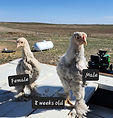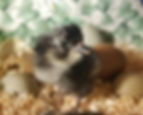HOW TO SEX CHICKENS
There are various traditional sexing methods to assist to identify male/ female chickens. Different methods are used based on breed, age, and comb types. Traditional sexing methods vary in percent of accuracy. While sight sexing can offer clues, it is often uncertain until crow or egg laying. Traditional sexing methods keep families searching for clues in the sexing mystery until crow or egg gifting. Investing in DNA sexing is the only truly accurate method.
Looking for help? If you want the community to give their educated guesses about your chickens, click 'Ask the Community' and upload photos of your chickens. It is best to take a side profile photo and a close up of waddles/comb. Notate the age of the chicken in question. In this article you can find out more information on traditional sexing methods or you may click to view the birds we have available by age or by breed to scroll through their product photos to view appearance of male and female counterparts.





BABY CHICK: VENT SEXING by Professionals Only
Breeds that use this sexing method: Standard sized breed chickens.
Vent sexing should only be attempted by professional sexers. There is a risk of prolapsing the chicks vent resulting in death if done incorrectly. Vent sexing only works on days old chicks. After that, the chick's lower digestive tract will distend from eating and growing which blocks the sex organ from view.
Venting involves squeezing the feces out of the day old chick, which opens up the chick's anal vent (called a cloaca). The professional sexer looks at genitalia eminence to classify the chick as a male or female. Male genitalia eminence is more elastic, boundary contour, lustered, and genitalia eminence is revealed as bump. Females can have smaller bumps which contribute to 10%- 15% inaccuracy in the vent sexing method.
Bantam breeds are too small to vent sex. Vent sexing is not available for bantam breeds such as Silkies which are usually sold only as straight runs. Which is why our offering of female sexing coverage or DNA sexing for Silkies is so unique.
BABY CHICK: AUTO SEXING
Breeds that use this sexing method: 55 Flowery Hens, Bielefelder, Cream Legbar
Thanks to the geneticist Reginald Punnett, who during the First World War mastered the technique of cross-breeding chickens carrying the barred gene (B) with others to produce sex-linked chicks with plumage differences that could easily be distinguished. Sex link breeding only works for the first generation of chicks. The value of an auto-sexing breed is that the visual distinction between male and female is persevered generation after generation.
While DNA sexing is the only truly accurate sexing method. These breeds offer the highest sexing accuracy of around 95%. Auto sexing breeds assist with determining day-old males by feather color. Males are lighter in color and have a white spot on their heads. Females are darker in color.

BABY CHICK: WING SEXING
Breeds that use this sexing method: Barred Plymouth Rock, Coronation Sussex, Rhode Island, Speckled Sussex, and Wyandotte
Not all breeds are able to be wing sexed. The gene must be bred in their DNA. The rate of feathering and plumage color is carried on the Z chromosome. When the primary feathers (bottom row closest to the wing’s edge) are longer than the coverts (top row of feathers), the chick is female. When the primary feathers are the same length or shorter than the converts, the chick is male.
Wing sexing has an accuracy rate of 80%, depending on the bloodlines. Once the newborn chick’s down dries, the coverts and primary feathers are examined. Sexing by the difference in the growth of the primary feathers is only possible before 3 days of age. After that, the cockerels’ wing feathers catch up with the pullets’ making sexing impossible.



BABY CHICK: CREST SEXING
Breeds that use this sexing method: Polish
Polish chicks can be challenging to sex using traditional feather or vent sexing methods due to their uniqueness. Gender identification gets easier as they mature by observing crest shape but accuracy at hatch is generally only about 75%. A female chick's crest is round and full and located at the front of her head, while a male's is oval and runs more toward the back of his head. Close observation of their crest shape reveals further clues to their sex as they age. Males tend to develop wild, spiky crests (true chicken mohawks) while females have more rounded, tidy crests. As adults, it is obvious with rooster appearing like 80's rock band hair do and hens maintaining a tight crest as if it was just released from curlers. Female coverage is provided for all females we offer. Refer to our Sexing Selection section to learn more.

BABY CHICK: SIGHT SEXING
Breed: Rhode Island
Male chicks have lighter shade on their down over the web of the wing, but female chicks do not. After the chick's down is shed, it will no longer be visible. The size of the spot varies greatly, leading to 10% inaccuracy.

Breed: Barred Plymouth Rock
The "barring" plumage pattern on Barred Plymouth Rock chicks allows the males and females to be differentiated at birth. The white dot on a female’s head is a defined spot while the male’s white dot is an undefined spot often running into his neck. The color of their legs and feet are also different as chicks. Male leg pigment is also lighter than his female counterpart. This sexing method is about 90% accurate.



BABY CHICK: DNA TESTING
Breeds include: All (including bantams such as Silkies)
DNA can determine sex using feathers, two or three drops of blood or eggshells from newly hatched birds. If you do not want to wait for your chick to grow older to confirm sex, A DNA test is the only 99.9% accurate sexing method that applies to all breeds of chickens.
Some breeds, especially Silkies, are not able to be sexed by external characteristics. For those living in the city, our sexing guarantee coverage helps ensure the family doesn’t get stuck trying to home an unwanted rooster. However, for some families, the emotional connection is strong after raising the chick for 3-6 months an surrendering their beloved rooster can be avoided through chick DNA sexing. DNA testing is a larger financial investment and is typically considered for families that do not want to develop a long term bond before identifing the sex of their chicken.
When ordering a DNA sexed chick from us, it can take up to 2 weeks for results. We test multiple chicks to ensure at least 1 chick out of the testing group results in a female confirmation. Please keep in mind we do not believe in shipping live animals. Thus, our out of state families typically plan a vacation to Colorado and purchase a 2-year supply of our sprouting feed to help make the trip worth while.

WEEK OLDS: TAIL FEATHER SEXING
Breeds Include: Barred Plymouth Rock, Rhode Island, Wyandotte, Orpington, Sussex, and Brahma.
Heavy Asian, American, and English chicken breed cockerels have tail feathers that are stumpy, curved; slow to develop. While, pullet tail feathers are long, straight; quick to develop. This sexing method is approximately 80% accurate.
Since Mediterranean and other light breed cockerel have tail feathers that are curved, but only slightly shorter and slower to develop than pullets, those breeds can not be sexed with this method.

JUVENILE CHICKENS: WADLES
Breeds include: All
Since chickens are not able to sweat, they cool themselves through blood circulation. Their waddles and combs are highly concentrated with capillaries and veins allowing overheated blood to pass through. The air cooled blood reduces the chicken’s internal temperature. Thus, waddles are a bright red color as they age.
Wattles are absent as newborns. Cockerels’ wattles develop and often begin to redden as early as 5-6 weeks of age. Hen wattles are a sign of maturity. Hens wattles will turn bright red/pink when closer to point of lay (4-9 months in age).
Note: Ayam Cemani, Onyx Sundance, and Silkie waddles and combs are black in color making this method less accurate. Silkie cockerel waddles usually take longer to develop than other breeds and are often hidden by those sporting a beard. DNA sexing is the only reliable way to sex a silkie until fully mature.

JUVENILE CHICKENS: SINGLE COMB SEXING
Breeds include: Ayam Cemani, Barnevelder, Barred Plymouth Rock, Bielefelder, Cream Legbar, Frizzle Cochin, Orpington, Marans, Rhode Island, Salmon Faverolle, Sussex
Combs are absent as newborns. Cockerels’ combs develop faster and often begin to redden as early as 3 weeks of age. Around 5-6 weeks of age, their comb becomes a nice big red flag making claim of being a male. As pullets develop combs, they appear yellowish orange. Pullet combs will turn bright red closer to point of lay. Comb sexing at 5-6 weeks of age works best if you have multiples of the same breed to compare and contrast the developmental differences.
Note: Ayam Cemani and Onyx Sundance single combs remain black. Thus, you can only judge by the size of comb and not the color.
JUVENILE CHICKENS: PEA COMB SEXING
Breeds include: Amerucana, Brahma, Easter Eggers
Pea combs appear at the base of the beak and extend towards the top of a chicken's head. Pea combs are smaller than other combs and are fairly tight against their heads. Males have three connected rows of caruncles that look like rows of peas side by side. Females have only 1 row. The "peas rows" are little bumps, and are uniform in shape and size as juveniles. As the bird matures the comb grows, sometimes losing its neat, ordered appearance and becoming a large globule on their head.
JUVENILE CHICKENS: FEATHER COLOR
Breeds include: Barred Plymouth Rock, Bielefelder, Cream Legbar, Wheaten Marans, Salmon Faverolle
Auto Sexing male breeds such as 55 Flowery Hens, Barred Plymouth Rock, Bielefelder, and cream Legbar possess lighter feather color than their female counterparts.
Salmon Faverolle and Wheaten Marans can be sexed at 10-14 days of age by the wing color that develops. Males will only have black and white wing colors. Females have a mix of white, brownish, and limited black feathers on their wings.
ADULT CHICKENS: HACKLE FEATHER SHAPE
"Hackles" are the feathers around a chicken's neck. If feeling the need to protect themselves, all their hackles will stand up in order to make themselves look larger and more intimidating.
Hens have rounded oval shape feathers on their necks. Roosters sport longer, more pointed, and narrower hackle feathers. Fly fishermen often seek hackle feathers for tying flies.
ADULT CHICKENS: CREST FEATHER SHAPE
Adult Polish can be easily distinguished by their crest shape. Female crests are round and globular, male crests are long and tapered. A male’s crest resembles an 80s’ rock star hair style. A female’s crest appears like a hairdo with fresh from removing their curlers.
ADULT CHICKENS: BEHAVIOR
Crow Sexing
All healthy roosters will eventually crow. While rare, it is possible that a hen will crow if raised in an all hen flock. Thus, crowing may not be a 100% sex indicator. With that said, you are not allowed a crowing hen within city limits. Your neighbor and laws care more about the noise. In our sexing guarantee coverage, we provide homes for the rare hens that crow to encourage peace with your neighbors.
Egg laying Sexing
Only hens can lay an egg. If she is laying, she is definitely a hen!
While not a quick determination, waiting for a crow or egg method is the only practical, truly accurate way to determine the sex unless investing in DNA sexing.
To view age progression photos, select the breed and view all the photos on our product pages:
Ameraucana Brahma Bielefelder Bantam Cochin Cream Legbar Easter Egger Frizzle Cochin Marans
Olive Egger Orpington Barred Rock Polish Rhode Island Salmon Faverolle Silkie Sussex Wyandotte


















































